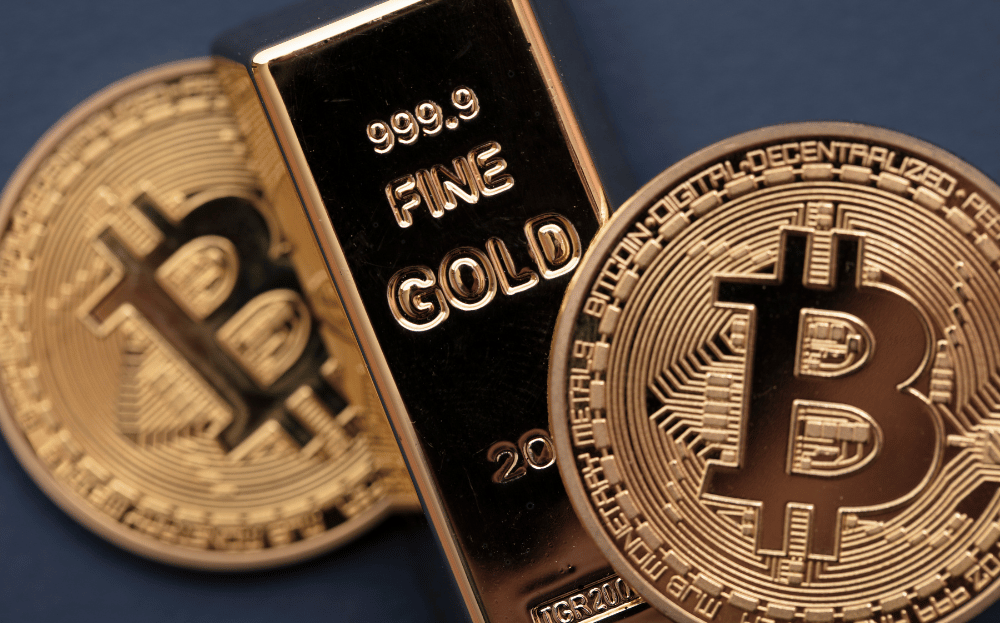The recent major crash in the crypto market has once again shaken the world of digital finance. In this hyper-connected, algorithm-driven era, trust seemed to have shifted from gold to digital code. Yet, the crypto crash of 2025 proved that technology does not necessarily guarantee stability.
Over the past few years, digital assets have been hailed as the symbol of a fast, modern, and decentralized financial future. However, the latest crisis revealed that public trust cannot be sustained by technology alone. When markets turn volatile, people still seek something tangible something real and reliable and that something is gold.
The 2025 Crypto Crash and the Root Cause of Digital Finance’s Fragility
A massive shock hit the crypto world on October 10–11, 2025. After U.S. President Donald Trump announced a 100% tariff on Chinese technology products, panic swept across global markets. Bitcoin plunged from around USD125,000 to roughly USD102,000, while Ethereum tumbled to the USD3,400 range.
The domino effect spread rapidly across the market. Altcoins such as Solana and Cardano fell by as much as 30%, wiping out nearly USD800 billion in global crypto market capitalization within a single day. The total market value, once above USD3 trillion, was abruptly slashed.
Still, not all was bleak in the crypto space. By Monday, October 13, 2025, signs of recovery began to emerge. Global market capitalization rebounded to USD3.87 trillion, supported by a surge in trading volumes of exchange-traded crypto products (ETPs), which doubled the annual average to USD53 billion per week.
Yet behind those numbers lies an important lesson. Geopolitical tensions, excessive leverage, and institutional fund outflows exposed the fragility of the crypto ecosystem. Even in a fast-paced digital world, one timeless truth remains: markets are still governed by human trust and psychology both of which can shift in an instant.
Crypto Crash Lessons: Why Technology Doesn’t Mean Stability
The vulnerability of digital systems resurfaced when selling pressure intensified and liquidity dried up. Automatic liquidation mechanisms originally designed to maintain market stability ended up worsening the crash. Without any major hacks or software bugs, this event demonstrated that technology alone cannot contain collective investor panic.
The root cause of the meltdown lay not in technical failure, but in a liquidity crisis within the derivatives market. When Bitcoin failed to hold the USD126,000 level, a chain reaction followed. Over USD600 million worth of leveraged positions were liquidated in just two days, forcing many investors to close out trades to stem their losses.
Major platforms like Binance and Coinbase remained operational, but the surge in transactions drove up fees and slowed execution speeds, especially on the Ethereum network. Instead of providing protection, aggressive leverage systems accelerated the market’s decline and exposed the limits of digital market design in times of crisis.
Analysts highlighted this as a crucial signal for the industry’s future. Ash Crypto called the automatic liquidation mechanism a “weapon of mass destruction,” while CryptoAmsterdam viewed the major correction as a natural consolidation phase an adjustment toward a more mature and realistic market.
In other words, the crypto sector is undergoing a healthy correction toward a more sustainable ecosystem. Major market shocks like this serve as a natural test of investor resilience and the quality of digital projects. Only assets and platforms with strong fundamentals will endure, while the rest will be filtered out by the market’s natural selection.
Also Read: 5 Reasons Why Digital Gold Is the Safest Investment – Treasury
Why Modern Finance Needs Balance, Not Just Innovation
Amid the rapid pace of financial innovation, a growing awareness has emerged: technological progress must not come at the expense of stability. Without a foundation of trust and consumer protection, innovation can easily breed new forms of panic as seen in the crypto market.
Global and national regulators are now emphasizing the importance of balance. Bank Indonesia, the Financial Services Authority (OJK), the Commodity Futures Trading Regulatory Agency (BAPPEBTI), and even the IMF agree that robust regulation is essential to ensure that digital transformation remains safe, transparent, and sustainable for all.
Through its Blueprint for the Indonesian Payment System 2025, Bank Indonesia underscores the need for inclusive and efficient payment systems. OJK is strengthening technological risk governance, while BAPPEBTI continues to oversee digital asset trading including crypto to ensure transparency and consumer protection.
Globally, the trend is moving in the same direction. More than 100 jurisdictions have tightened oversight of stablecoins and Central Bank Digital Currency (CBDC) projects. This reflects a collective effort to build a digital financial system that is not only innovative but also resilient to systemic risks and cyber threats.
Interestingly, an Ipsos 2025 survey found that public trust in Indonesia’s digital banks and online financial services continues to rise. Security, convenience, and transparency are the main factors driving this trend. This underscores one key insight: innovation only holds real value when it’s accompanied by asset diversification strategies including gold investments as a safe haven during financial turbulence.
When Crypto Falls, Gold Shines as a Safe Haven
As the crypto market tumbled, investor attention turned back to gold. The precious metal once again demonstrated its resilience amid digital market chaos, reaffirming that stability and trust remain the cornerstones for anyone seeking protection in a rapidly changing global economy.
The surge in gold demand coincided with a massive sell-off in digital assets. Retail investors began realizing that extreme volatility in the digital world could threaten their portfolios. As a result, many shifted to gold a more stable, tangible, and enduring asset that withstands short-term market shocks.
This phenomenon, known as the safe haven shift, reflects a major migration toward safer assets. Global analysts, including those from UBS and Standard Chartered, forecast that gold’s upward trend will continue. The metal remains a natural hedge against inflation, currency depreciation, and unpredictable geopolitical risks.
In Indonesia, a similar pattern is emerging. Prices of Antam gold bars continue to rise, while interest in digital gold platforms such as Treasury is growing rapidly. Through these platforms, investors can purchase gold starting from small denominations, with secure storage, transparent ownership, and the option to convert it into physical form anytime.
The popularity of digital gold illustrates that innovation and security can coexist. Many investors now see Treasury not just as a modern investment platform, but as a practical way to preserve value without losing the timeless essence of owning real gold.
Ultimately, the crypto crash of 2025 serves as a powerful reminder: beneath all the speed and sophistication of digital technology, humans still long for tangible stability. Whether in physical bars or digital form, gold remains the enduring symbol of trust a steadfast anchor in an ever-changing financial world.











